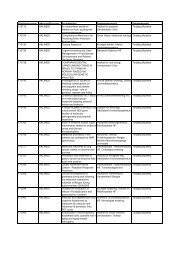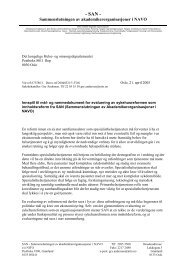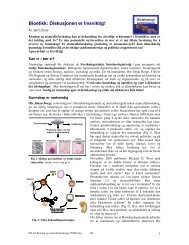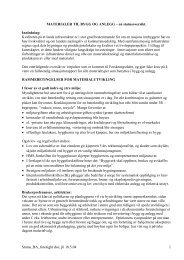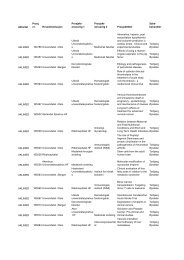A Revolution in R&D
A Revolution in R&D
A Revolution in R&D
Create successful ePaper yourself
Turn your PDF publications into a flip-book with our unique Google optimized e-Paper software.
processes now so different from before, many<br />
disparities and stresses will <strong>in</strong>evitably develop <strong>in</strong><br />
an unaltered managerial system. The old structures<br />
will creak and stra<strong>in</strong> under the unfamiliar<br />
new pressures. To restore congruence, a company<br />
may need to undertake some bold organizational<br />
reshap<strong>in</strong>g—shift<strong>in</strong>g or remov<strong>in</strong>g divisional<br />
borders, reassign<strong>in</strong>g personnel, redistribut<strong>in</strong>g<br />
areas of responsibility, and so on—not just with<strong>in</strong><br />
R&D, but also with<strong>in</strong> the company as a whole and<br />
even beyond, <strong>in</strong> the alliances the company might<br />
enter <strong>in</strong>to.<br />
The R&D Department. Incorporat<strong>in</strong>g the requisite<br />
new capabilities, it goes without say<strong>in</strong>g, represents a<br />
formidable organizational challenge: not only do<br />
they have to mesh with exist<strong>in</strong>g capabilities, they<br />
need to coord<strong>in</strong>ate with one another as well. To<br />
implement <strong>in</strong> silico drug design, for example, it<br />
would be almost essential to provide an <strong>in</strong>formatics<br />
<strong>in</strong>terface between structural biology and chemistry<br />
data. Meanwhile, a comparable reorganization of<br />
personnel has to be undertaken. Biologists and<br />
chemists, for example, can no longer proceed <strong>in</strong><br />
isolation, but must now work alongside each<br />
CASE STUDY: MANAGING CAPACITY—EMPOWERMENT THROUGH CPM<br />
A large pharmaceutical company was fac<strong>in</strong>g a capacity<br />
crisis. Both development and staff<strong>in</strong>g levels were<br />
under pressure, ma<strong>in</strong>ly as a result of productivity<br />
improvements <strong>in</strong> basic research and competition for<br />
scientific talent. As a key part of the remedy, the company<br />
undertook worldwide implementation of capacity<br />
plann<strong>in</strong>g and management—a considerable challenge<br />
for such a complex organization, where demand<br />
was uncerta<strong>in</strong> and resources were not fungible.<br />
Development of CPM had four ma<strong>in</strong> components:<br />
• Quantify<strong>in</strong>g capacity and demand. Appropriate<br />
units of capacity and demand were def<strong>in</strong>ed for<br />
each function. In cl<strong>in</strong>ical departments, for<br />
<strong>in</strong>stance, the typical unit of capacity was def<strong>in</strong>ed<br />
as a team of monitors, coord<strong>in</strong>ators, and support<br />
personnel, and the unit of demand was a study.<br />
• Bus<strong>in</strong>ess processes. To exploit CPM fully and foster<br />
cooperation among departments and project<br />
teams, various new bus<strong>in</strong>ess processes were <strong>in</strong>itiated—most<br />
importantly, the track<strong>in</strong>g and <strong>in</strong>terpretation<br />
of demand and capacity <strong>in</strong>formation, and<br />
the consequent adjustment of timel<strong>in</strong>es and<br />
resource allocation. Appropriate l<strong>in</strong>kages needed<br />
to be made to related functions such as facilities<br />
plann<strong>in</strong>g and human resources.<br />
• Change management. S<strong>in</strong>ce CPM tends to affect<br />
deeply the way an organization operates—publi-<br />
ciz<strong>in</strong>g the relative productivity and workload of<br />
different departments, for example—some managers<br />
react more negatively than others. The company<br />
took steps, both before and dur<strong>in</strong>g the<br />
implementation of CPM, to ease the transition.<br />
The message was constantly re<strong>in</strong>forced—that the<br />
changed regimen was beneficial, essential, and<br />
permanent.<br />
• IT support. With CPM quickly generat<strong>in</strong>g a wealth<br />
of <strong>in</strong>formation, some centralized and some requir<strong>in</strong>g<br />
broad dissem<strong>in</strong>ation, the company recognized<br />
that its CPM <strong>in</strong>itiative needed extra IT support. It<br />
identified suitable vendors with the requisite flexibility<br />
and pharmaceutical experience.<br />
The CPM endeavor has been widely hailed. No<br />
longer is the question “Do we have the capacity to<br />
do these projects?” met with silence. Nowadays, the<br />
CPM team can provide a detailed, graphical depiction<br />
of capacity and demand <strong>in</strong> each department and<br />
overall, and an analysis of the capacity impact of<br />
each project.<br />
Look<strong>in</strong>g ahead, the company expects CPM to contribute<br />
to enhanced revenues, by speed<strong>in</strong>g time to<br />
market and <strong>in</strong>creas<strong>in</strong>g the number of <strong>in</strong>dications per<br />
compound. It also expects to use CPM to improve<br />
portfolio management, and to save costs through<br />
more rational <strong>in</strong>vestment <strong>in</strong> hir<strong>in</strong>g and facilities.<br />
53



